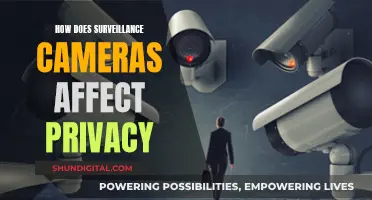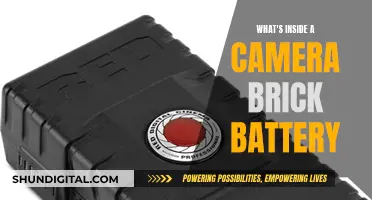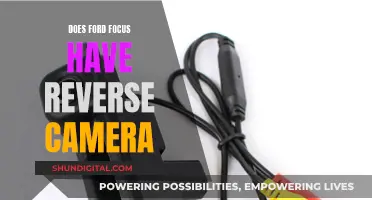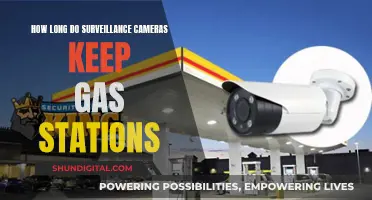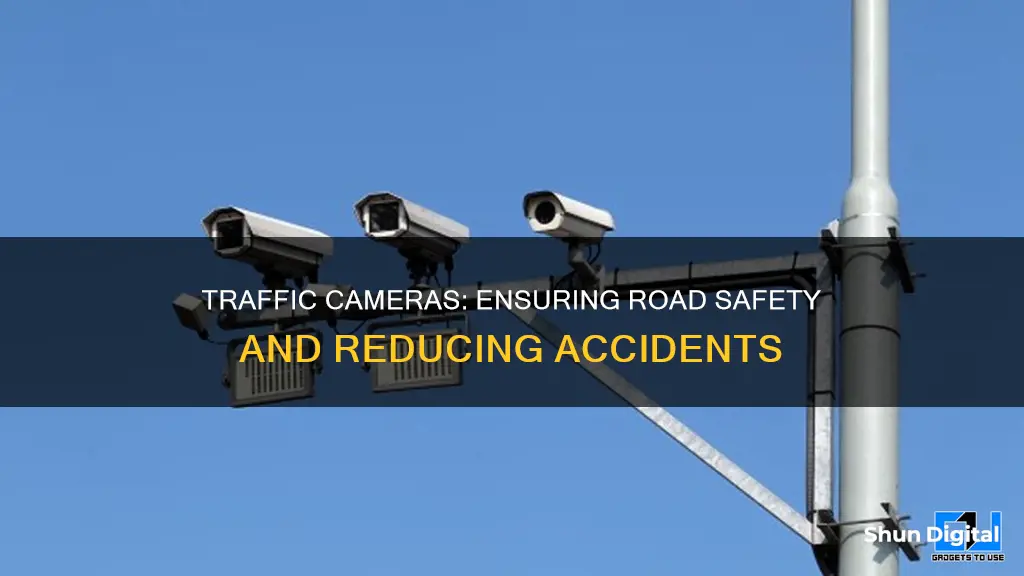
Traffic cameras are an increasingly common sight, but what about those cameras at traffic signals? Red light cameras are a type of traffic enforcement camera that captures images of vehicles that have entered an intersection after the traffic signal has turned red. They are usually placed at busy junctions and are typically bulkier with a large camera box and two external flashes. Once a vehicle crosses the stop line, the camera takes a picture of the license plate and, in some cases, a video of the violation. The data and images are then sent to the relevant law enforcement agency. These cameras are controversial, with some arguing that they are more interested in generating revenue than improving safety. However, studies have shown that they can reduce crashes and improve overall road safety.
| Characteristics | Values |
|---|---|
| Purpose | To monitor traffic flow and signal violations |
| Location | Busy intersections |
| Function | To capture images of vehicles that run red lights |
| Data captured | Location, date, speed, time taken to cross the intersection |
| Activation | When a vehicle crosses the designated "stop line" |
What You'll Learn

To improve road safety by discouraging reckless driving
Traffic cameras are an increasingly common feature of roads worldwide, and they serve a variety of purposes. One of their primary functions is to improve road safety by discouraging reckless driving.
Red light cameras are one of the most well-known and controversial types of traffic cameras. These cameras are placed at busy intersections and are designed to detect when a driver enters an intersection on a red light. If a violation is detected, the camera will capture multiple images of the car, as well as the license plate, and the driver will receive a ticket in the mail. Red light cameras are typically bulkier than other camera systems and consist of a large camera box with two external flashes, often mounted on separate poles. They are also usually positioned at the side of the road, facing the intersection.
The use of red light cameras is controversial, with some arguing that they are more interested in generating revenue from tickets than improving safety. There is also a concern that these cameras may cause more accidents as drivers may suddenly stop to avoid a ticket, leading to rear-end collisions. However, studies have shown that red light cameras can be effective in reducing right-angle crashes and related injuries. For example, a study of 50 intersections in Houston found that red-light cameras reduced collisions by about 28%, and another study in six Virginia communities found a 42% decrease.
Another type of camera used to improve road safety is speed cameras. These cameras track the speed of vehicles and can be found in neighbourhoods, along stretches where drivers are known to speed, or on city roads. Speed cameras can be fixed in specific locations or mobile, making them harder to detect. Mobile speed cameras are often handheld or mounted within police cars and use radar or laser technology to detect speeding.
Like red light cameras, speed cameras are controversial, with some arguing that they are more about making money from tickets than improving safety. However, studies have shown that speed cameras can be effective in reducing speeding and the number of accidents and injuries on the road.
In addition to red light and speed cameras, traffic sensor cameras and automatic number plate recognition (ANPR) cameras also play a role in road safety. Traffic sensor cameras are installed on top of traffic signals or mounted high on light poles, and they help to monitor traffic flow and determine traffic light timing. ANPR cameras, on the other hand, are used to track the whereabouts of drivers by reading license plate numbers. While some criticize these cameras as an invasion of privacy, others argue that they can be useful for law enforcement, such as in the case of a driver with an outstanding warrant.
Overall, while traffic cameras may be controversial, they have been shown to be effective in improving road safety by discouraging reckless driving behaviours.
Surveillance Camera Setup: Internet Connection Guide
You may want to see also

To generate revenue from traffic violations
Traffic cameras are often used to generate revenue from traffic violations. These cameras are usually dome or cylinder-shaped and are commonly found on top of traffic signals or light poles. They are typically enclosed in a weatherproof covering. While the design and usage of these cameras vary depending on the manufacturer and the city, most red light camera systems are triggered when a vehicle enters an intersection after the light has turned red. The camera captures an image of the license plate, and a ticket is then mailed to the vehicle's registered owner.
In some states, such as Texas, red-light enforcement cameras have been banned due to public pushback and legislation. However, in other states, these cameras are still used to enforce traffic laws and generate revenue from violations. It's important to note that the effectiveness of these cameras in improving road safety is debated, and some groups argue that they are primarily used for "revenue-raising" rather than enhancing road safety.
The revenue generated from traffic camera violations can be significant. For example, in the UK, it was estimated that an additional 800 people could be killed or seriously injured on the roads each year if all speed cameras were removed. This highlights the potential impact of these cameras on road safety and the consequent financial implications for violators.
While the use of traffic cameras for enforcement purposes has its critics, it is clear that they can be an effective tool for deterring and penalizing traffic violations. The revenue generated from these violations can be substantial and may influence policy decisions regarding the implementation and retention of these camera systems.
Overall, while the primary purpose of traffic cameras should be to improve road safety, the generation of revenue from traffic violations is an important consideration for local and state governments.
US Surveillance: Cameras Everywhere, Privacy Nowhere?
You may want to see also

To monitor traffic flow and signal violations
Traffic cameras are often placed on top of traffic signals to monitor traffic flow and signal violations. These cameras are typically basic traffic cameras that do not issue tickets. Instead, they monitor traffic patterns and help manage traffic effectively. They are usually small, cylindrical, or dome-shaped cameras enclosed in weatherproof housing. By tracking traffic flow, these cameras can assist in determining the appropriate timing for traffic signals, ensuring a smoother flow of vehicles.
Red-light cameras, on the other hand, are typically located at busy intersections or on the side of the road facing the intersection. They are designed to detect and capture vehicles that enter an intersection after the traffic signal has turned red. These cameras are usually bulkier and consist of a large camera box with external flashes. When a vehicle crosses the stop line on a red light, the camera is triggered, capturing images of the license plate and, in some cases, a video of the violation.
The images and videos captured by red-light cameras serve as evidence for law enforcement authorities to enforce traffic laws. They help improve road safety by discouraging reckless driving behaviours, such as running red lights. Additionally, red-light cameras can also capture the location, date, speed, and the amount of time that elapses once a vehicle has entered the intersection.
While red-light cameras are controversial, with some arguing that they are more interested in generating revenue than improving safety, studies suggest that they can be effective in reducing certain types of accidents and injuries. For example, the city of Chicago experienced a 40% decrease in accidents resulting in injuries after implementing red-light cameras. However, it is important to note that the overall impact of red-light cameras on collision rates has been mixed, with some studies indicating an increase in rear-end collisions.
Speeding Camera Tickets: Enforceable or Not?
You may want to see also

To capture images of vehicles that run red lights
Red light cameras are a type of traffic enforcement camera that captures images of vehicles that run red lights. These cameras are placed at busy intersections and are triggered when a vehicle enters the intersection after the traffic signal has turned red. The cameras typically capture a series of photographs or a video clip, providing evidence of the violation. The photographic or video evidence is then reviewed by a law enforcement official to determine if a violation occurred. If a violation is confirmed, a citation or ticket is usually mailed to the owner of the vehicle.
Red light cameras are designed to improve road safety and reduce crashes caused by red-light running. They serve as a deterrent and provide a way to identify and penalize drivers who break traffic laws. The cameras are often installed in protective metal boxes attached to poles at intersections, specifically chosen due to high numbers of crashes or red-light violations.
The use of red light cameras has sparked some debate, with critics arguing that their primary purpose is financial gain rather than public safety. There are also concerns that these cameras may cause more sudden stops, leading to an increase in rear-end collisions. However, studies have shown that red-light cameras are effective in reducing right-angle crashes and related injuries.
Red light cameras are typically bulkier than other camera systems and consist of a large camera box with two external flashlights mounted on poles at intersections. They are easily identifiable by their location and appearance. The cameras may capture multiple images of the violating vehicle, including its license plate, to ensure clear evidence of the infraction.
Overall, red light cameras play a crucial role in enforcing traffic laws, deterring dangerous driving behaviour, and improving road safety, especially at busy intersections.
Charging Your Kodak Camera: A Step-by-Step Guide
You may want to see also

To reduce the number of car crashes
Traffic cameras are an increasingly common sight on roads across the world. One of their primary purposes is to reduce the number of car crashes and improve road safety.
Red-light cameras are one of the most common types of traffic cameras and are used to detect when a vehicle enters an intersection after the signal has turned red. They are usually placed at busy intersections and junctions and are triggered when a vehicle crosses a designated 'stop line' or enters the intersection after the light has turned red. The camera will then take multiple images of the car and its license plate, which can be used as evidence by law enforcement officials.
These cameras are controversial, with some arguing that they are more interested in generating revenue from fines than improving safety. There is also a concern that they may cause an increase in rear-end collisions as drivers brake suddenly to avoid a ticket. However, studies have shown that red-light cameras are effective at reducing right-angle crashes and related injuries. They also provide an objective approach to issuing traffic citations, reducing the potential for negotiation with law enforcement officers.
In addition to red-light cameras, there are also speed cameras, which detect and record vehicles exceeding the speed limit. These cameras can be fixed, mounted on poles or traffic lights, or mobile, handheld, or mounted within police vehicles. Like red-light cameras, speed cameras have been shown to be effective in reducing speeding and accidents, although they are also controversial.
Overall, while traffic cameras may be unpopular with some drivers, they have been shown to be effective in reducing crashes and improving road safety. They also save money by cutting down on the need for active police patrols and can provide valuable evidence in the event of an incident.
Traffic Cameras: How Far is Too Far?
You may want to see also
Frequently asked questions
Cameras on traffic signals are called red light cameras.
Red light cameras are automated ticket-issuing systems that detect when a motorist enters an intersection on a red light. They take multiple images of the car during the violation and capture the location, date, speed, and time taken to enter the intersection.
Red light cameras are placed at busy intersections, usually mounted on the side of the road facing the intersection.
Red light cameras are triggered when a vehicle crosses a designated "stop line" or enters an intersection after the signal has turned red. They use camera-based image analysis to detect the light status and capture the license plate of the violating vehicle.
Red light cameras are used to enforce traffic laws and improve road safety by discouraging reckless driving behaviours, such as running red lights.


